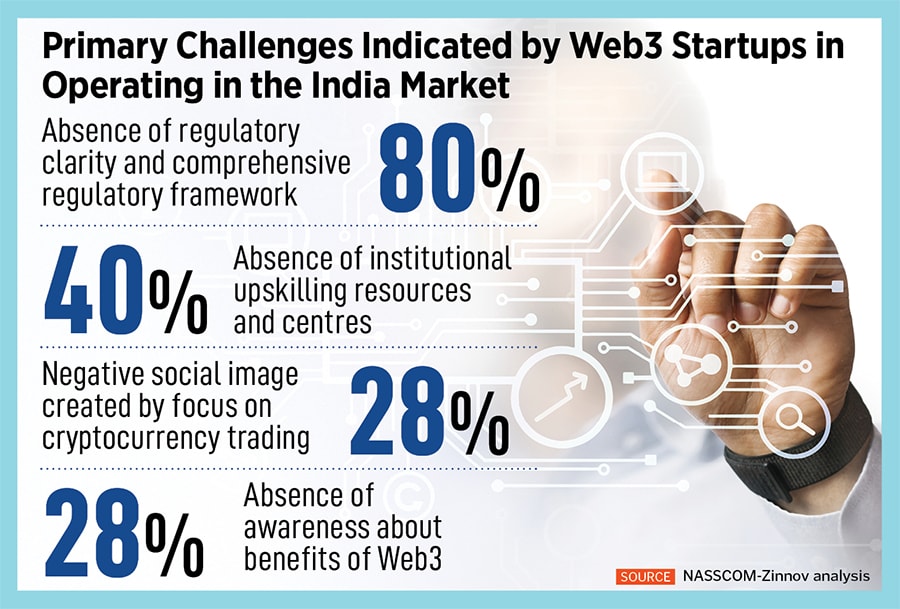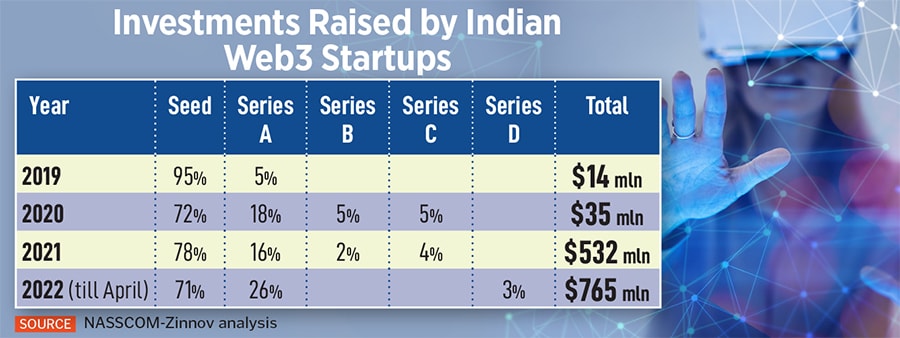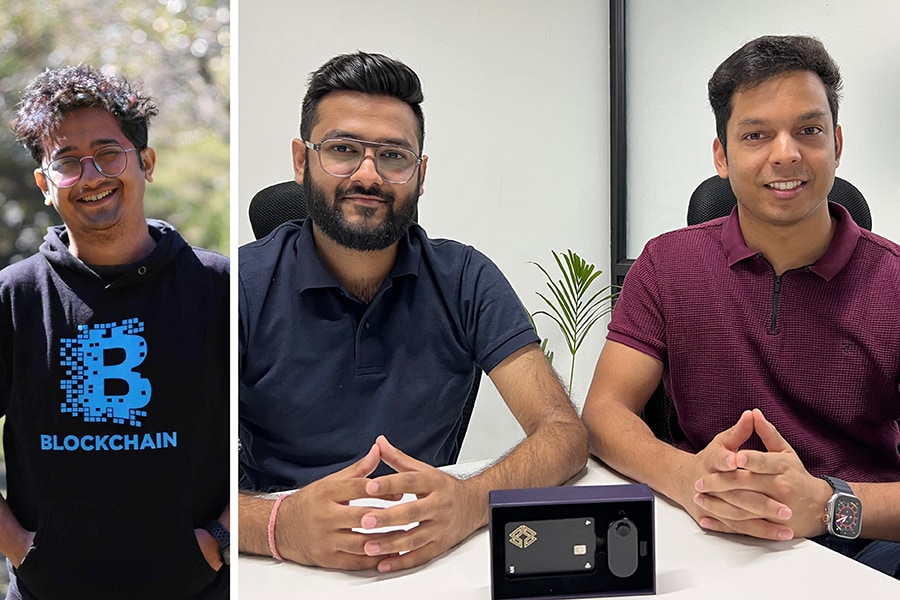India can lead the Web3 revolution, but lack of regulations can be a business-ki
Despite the challenges, Web3 startups and experts in India remain optimistic, and hope to see the transition from Web2 to Web3 within this "techade"


Fun fact: If Apple had not fired Steve Jobs in 1985, we may not have seen Web or Web3 today.
Jobs founded NeXT Computer after he was sacked from Apple. In 1989, he sold one NeXT machine to a computer scientist working at CERN, the European organisation for nuclear research. This move would forever change the world. Tim Berners-Lee invented World Wide Web (WWW) using this machine, and it became the world"s first web server and ran the first web browser. The main purpose of Web 1.0 was to share information—it was read-only and excluded a large portion of the population as it was difficult to use.
This limitation prompted a Web 2.0 movement. Popularly known as the social web, Web 2.0 is something we experience on a daily basis through various internet companies like Google, Facebook, Twitter, Anchor and more. Everything was going fine until people started doubting the competence of these tech giants. A lot of them have been accused of selling user data, some have suffered security breaches, and others have attempted invading user privacy. All these concerns gave rise to Web 3.0 to give users back control of their data on the internet.
Still under construction, Web 3.0 is said to be the decentralised web. The idea here is to establish trust on the internet without the intervention of any central body like the government and large companies. This trust is established using blockchain technology, a decentralised way of storing and sharing data using cryptography, distributed networks and ledger systems. Last year, a report by Vantage market research stated that the global Web 3.0 blockchain market revenue is expected to reach a value of $23.3 billion in 2028.
Companies from developed nations were at the forefront of the Web1 and Web2 evolution. This scenario is likely to change in Web3. As the most populous economy, experts suggest that India has a potential to be the global player in the Web3 market. Eleven percent of global Web3 talent is in India, making it the third-biggest talent pool in this sector, after the US and China. This pool is growing at the fastest rate worldwide, at 120 percent likely in the couple of years, according to a study by NASSCOM. There are over 450 Web3 startups in the country that have got $1.3 billion in investments in the last two years. Over 160 of these startups were founded between 2021 and 2022. However, due to a lack of clarity on regulations, 60 percent of Indian Web3 startups are registered outside, but hire tech workforce in India.
Achyuta Ghosh, head of NASSCOM Insights, suggests that Web3 applications should be regulated instead of the technology itself. “The moment something new comes up, people want to regulate it. They want to control it and put guard rails. We should regulate applications, not technology. There’s no framework from the government. So, people don"t know really whether they want to go full steam into this or want to hold off, wait and watch. This approach doesn’t work for emerging tech. We only end up losing on the opportunity."

India is one of the fastest emerging countries in Web3 from a developer and provider standpoint. But there is still a long way to go in terms of adoption and user base. And the biggest stumbling block of regulatory concerns has been looming large for years. Addressing regulatory concerns can provide a clear path for innovation. It is crucial for ensuring stability in the industry and fostering further innovation in India, explains Neeraj Khandelwal, co-founder of CoinDCX, a crypto trading platform which is now expanding its focus towards bridging the gap between individuals and Web3.
“For stability and mass adoption, it is crucial to establish a robust regulatory framework for the Web3 industry. Clear regulations that govern the boundaries between the real world and crypto will enable safe intersection between the two worlds, bringing innovation to the real world economy and value to the decentralised finance (DeFi) and Web3 economy," says Khandelwal.

Web3 startups in India have grown six-fold since 2015, as investments in them soared since the beginning of 2020. The founders are leveraging blockchain technology in adaptable ways to solve a multitude of problems across segments. The focus area is on BFSI, enterprise tech, consumer tech and edtech, among the others. These Web3 startups have focussed less on cryptocurrency trading, and more on building diverse Web3 solutions across all major application areas in finance, entertainment and infrastructure.
One such startup is Gurugram-based Cypherock which has built a hardware wallet to empower people to be self-sovereign, and have the same peace of mind and control with their crypto and personal data that they have with their savings in bank vaults. Their hardware wallet, Cypherock X1, is designed to allow individuals to self-custody their crypto and improve crypto security by mitigating any single point of failure in private key management. It claims to be the first hardware wallet without a seed phrase backup, and it never stores private keys in a single place, making it the most secure wallet. Founded in 2019 by Rohan Agarwal and Vipul Saini, the Web3 security company raised $1 million in December last year, co-led by a bunch of investors.
“We are currently monetising through hardware sales only. We will soon be launching a recovery service that, if setup, will allow users to pass on their Web3 assets to their loved ones in case something bad happens to them without Cypherock ever in control of the assets itself. That will be an optional annual subscription that users can subscribe to if they want," says Agarwal.
Web3 business models reward the users with a token, and the value is shared between the users and companies. There are other revenue streams as well. Web3 startups are monetising in various ways starting from traditional internet models like SaaS fees, transaction fees to Web3 native models like charging for network usage, treasury tokens, asset monetisation, and engagement revenue like advertising, explains Pareen Lathia, co-founder of Buidlers Tribe.

Web3 as a journey is hard. The ups and downs are very steep compared to Web1 and Web2. For instance, in Web3, the downs come so fast that one falls off a cliff or shoots up like a rocket. The founders who have seen this for the last three cycles over six years, and the ones who stick to their mission by getting through that winter and don’t burn out end up creating good value, explains Nitin Sharma, general partner and global blockchain lead at Antler. Sharma was the first venture capitalist in India who started investing in Web3 startups and has been doing so from the last six years.
In the past some years, many new Web3 startups emerged in India and joined the bandwagon as they saw the investors pouring in money into the sector. “90-95 percent of tokens in the world are probably worthless. It"s just a matter of how long it takes before utility is proven or disappears. One of the problems in Web3 is that it attracts both the smartest people on one hand, as well as a lot of scammers and speculators. Another aspect is that you have to be globally competitive as a product or an ecosystem. I may have come across perhaps 500 Indian startups. Only 10 or so have actually made it big in the sense of having global consumers and developers. And that"s because those founders understood the power of collaboration and community," says Sharma.
Web 2.5 will serve as a bridge between both the worlds (Web2 and Web3). Decentralised technologies and the user interface of Web2 are integrated into Web 2.5 to facilitate a smooth transition to Web3. Every product of Web3 will be Web 2.5 in some sense. According to experts, Web3 is not a replacement for Web2. Just as Web2 is built on the original Web1 protocols, Web3 is a layer of decentralised data that travels through the internet. So, the base still remains the same: Phones, browsers, apps and protocols.
For instance, US-registered-but-from-India Huddle01 is a decentralised video conferencing platform that enables synchronous and asynchronous communication for wallets, dApps, DAOs, communities and users for free. It is similar to the likes of Zoom and Google Meet. Founded in 2020 by Ayush Ranjan and Susmit Lavania, the startup leverages blockchain technology to enable real-time communication.
 From left: Ayush Ranjan, co-founder of Huddle01, Rohan Agarwal and Vipul Saini, co-founders of Cypherock
From left: Ayush Ranjan, co-founder of Huddle01, Rohan Agarwal and Vipul Saini, co-founders of Cypherock
Indian startup funding is seeing a dry spell and yet Huddle01 managed to raise $2.8 million in a seed funding round from blockchain investment firm Hivemind. So far, the startup has raised $4.5 million in funding across multiple rounds from 19 investors. According to the startup, it has clocked in more than one million minutes of meetings.
“Huddle01 platform is Web 2.5. We are neither completely decentralised nor completely centralised. So, we have taken all the good components of the Web3 world, and plugged it into Web2 platforms, and offer best of both the worlds. For example, on an audio and video level, Huddle01 is still on a centralised server. But the meeting recordings are stored on filecoin, which is a decentralised storage network. This combination works better because still the centralised servers tend to perform better for us," explains Ranjan.

Every new technology comes with its share of challenges and hiccups. After some major events like the FTX fiasco, a lot of people are sceptical about the whole industry. To begin with, it will be crucial for the Web3 founders to spread awareness about this new sector. Mass adoption is another concern, the user experience of the Web3 products needs a lot of improvement. It will take seconds for Web2 users to give up on trying any new Web3 product if it’s difficult to navigate. Web2 apps like Facebook, Google and Instagram are user-friendly, and easily accessible compared to the Web3 products.
The whole adoption is a different ball game. A lot of POC (proof of concept) pilots are happening in India, but very few production systems are happening in the enterprise or the government space, explains Ravi Chamria co-founder and CEO of Zeeve Inc, an enterprise blockchain company. “We still lag behind in terms of adopting a new technology. Unless there are some proven use cases from the outside, we don"t tend to put in big investment. In our interaction with various enterprises, we have seen that. But I"m optimistic about the Indian market. In the next five years, we"ll start seeing a lot of adoption happening in the blockchain space."
With India having both a critical mass of consumers and the tech talent, for the first time, there is an opportunity to play on a level-playing field with global companies, says Rajesh Jain, who has been in the tech space from the last three decades, and is the founder and managing director of 25-year-old Netcore Cloud. “Having seen the early days of the internet, I sense a similar excitement with Web3. But uncertainty and excessive regulation are business killers. Given a history of retrospective actions and taxation by Indian governments, it is the rare brave entrepreneur who will create a Web3 company based in India. And when capital moves, so do people—and so does eventual wealth creation."
Recently, two major global Web3 companies, Algorand and Polkadot, jumped into the Indian Web3 space with AlgoBharat and PolkadotNow India initiatives. To expand its global presence, the popular blockchain protocol Algorand has set its sights on India, making it a new hub for technological advancements. Algorand aims to transition India from Web2 to Web3. It has created ‘AlgoBharat’, a wing dedicated to India, to expand the Web3 ecosystem in the country and support related startups.
Not only are the developers going to come from India, but the solutions are going to be built in India and for India. India will be the hub of innovation, says Algorand’s vice president and India country head Anil Kakani. “And those solutions are then going to be taken to other markets. We don"t see the same Web3 innovation and solutions in a market like America because things there are so developed… it"s hard for disruption to happen. Contrarily, in India, there"s so much room for disruption, because millions of people still don"t have access. But I’d predict those solutions will have great utility and eventually be adopted outside India as well. I"m very bullish on the solutions that will be built on blockchain in the next ten years."
First Published: May 18, 2023, 13:14
Subscribe Now